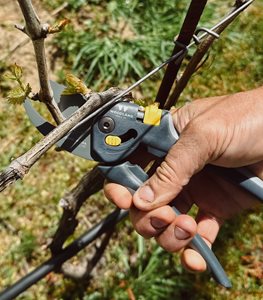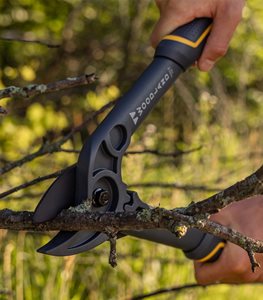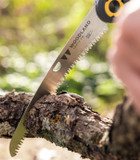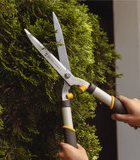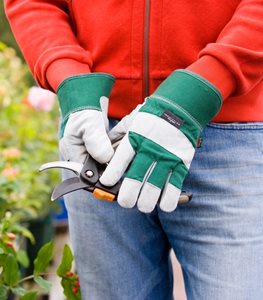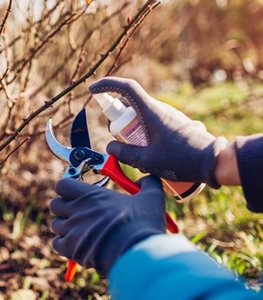Essential Pruning Tools
Choose the right tools for easy, effective pruningProper pruning begins with the right tools. Whether you're a novice gardener or looking to upgrade your existing toolkit, understanding the various pruning implements available can make your gardening tasks more efficient and enjoyable. The right tools not only make pruning easier but also ensure cleaner cuts, promoting healthier plant growth.
With the right tools in hand, you'll be well-equipped to keep your shrubs, trees, and garden in top shape year-round.
6 ESSENTIAL PRUNING TOOLS
HAND PRUNERS (Secateurs)
Best for: Cutting branches up to 1/2 inch in diameter
Types:
- Bypass pruners: Ideal for live, green branches. These have two curved blades that pass by each other like scissors, providing a clean cut that helps plants heal quickly.
- Anvil pruners: Better for dead, dry wood. These have a straight blade that cuts against a flat surface (the anvil), which can crush living stems, but works well for dead wood.
Features to consider:
- Ergonomic & comfortable grip
- Spring-loaded opening mechanism to reduce strain during repetitive cuts
- Locking mechanism to keep blades safely closed when not in use
- Maximum cutting diameter
LOPPERS
Best for: Branches 1/2 to 2 inches in diameter
Types:
- Bypass loppers: Similar to bypass pruners, best for live wood and green branches.
- Anvil loppers: Like anvil pruners, these are more effective on dead or dry wood.
Features to consider:
- Longer handles for increased leverage, allowing you to cut thicker branches with less effort
- Light weight for easier handling, especially for extended pruning sessions
- Some models have extendable handles for even greater reach and leverage
- Some have ratcheting systems for increased cutting power
- Maximum cutting diameter
PRUNING SAW
Best for: Branches over 2 inches in diameter
Types:
- Folding saws: Compact and portable, blade folds into the handle for safe storage and transport.
- Fixed-blade saws: Better for frequent or heavy-duty work; typically more robust.
Features to consider:
- Longer blades can cut larger diameters but may be harder to maneuver in tight spaces
- Comfortable, non-slip grip for safe handling
- More teeth per inch results in smoother cuts but slower cutting. Fewer, larger teeth cut faster but leave a rougher finish.
HEDGE SHEARS
Best for: Shaping hedges and trimming small-leaved shrubs
Types:
- Manual: Best for small hedges or precise topiary work. More affordable and quiet, but require more physical effort.
- Electric, gas, or battery-powered: Ideal for larger hedges or frequent use. Reduces physical strain but may be less precise than manual shears.
Features to consider:
- Longer blades cover more area but may be harder to control
- Shock-absorbing bumpers and ergonomic grips
- Lighter tools reduce fatigue during extended use
GARDEN GLOVES
Purpose: Protect hands from thorns, splinters, and blisters
Types:
- Cloth: Light pruning, planting, and general garden maintenance
- Leather: Heavy-duty pruning, especially with thorny plants
- Nitrile/latex-coated: Working in wet conditions or handling chemicals
- Cut-resistant: When using sharp pruning tools or dealing with plants with sharp edges
Features to consider:
- Longer cuffs offer more wrist and forearm protection when working with thorny shrubs
- Fit should offer protection, but maintain dexterity
DISINFECTANT
Purpose: Clean tools between cuts to prevent spread of disease from one plant to another
Types:
- Rubbing alcohol (70% isopropyl alcohol): Quick-drying and effective
- Diluted bleach solution (1 part bleach to 9 parts water): Highly effective but can corrode metal tools
- Hydrogen peroxide: Effective and environmentally friendly
Tip: Keep a spray bottle handy for quick application
BEGINNER'S TOOLKIT RECOMMENDATION
For those just starting out, a good quality pair of bypass hand pruners and a pair of loppers will handle most basic pruning tasks. As you gain experience and take on more complex projects, you can add other tools to your collection.
RELATED:
Pruning Guides
Essential Garden Tools
Garden Tool Care & Maintenance
